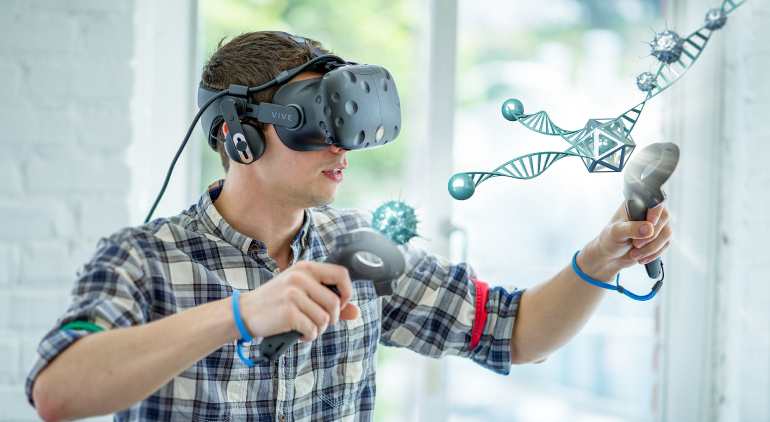The educational landscape is constantly changing and in this evolving educational world, it is crucial to understand the concept of virtual learning offered by immersive technologies like virtual reality. The introduction of VR learning in higher education classrooms has opened doors to an immersive, interactive, and engaging learning environment that overcomes the limitations of the traditional educational setup.
Let’s explore more about the potential of virtual reality in education in the blog below.
Advantages of Virtual Learning
Immersive learning experiences
Virtual learning transcends traditional education methods by immersing students in dynamic experiences. Through VR, learners venture beyond textbooks, exploring historical events, navigating ancient civilizations, and even conducting virtual dissections. And, all this is made possible without leaving their classroom, in a secure and controlled environment.
This transformative approach sparks curiosity and deepens understanding, offering a vivid alternative to conventional, static learning materials.
Increased Engagement
In education, VR stands as a remedy for disengagement often associated with traditional lectures. By turning learning into a captivating experience rather than a passive method, VR grabs and sustains the attention of the students. Real-time interactivity and feedback transform the educational landscape, ensuring that learners remain actively and enthusiastically involved throughout the learning process.
Accessibility and Inclusivity
The introduction of virtual reality in education has dismantled all the barriers of the traditional classroom. With the help of VR, higher educational institutions have opened the doors of education for students throughout the globe, irrespective of geographical constraints.
Asking how?
Simple, by wearing a VR headset. All they have to do is wear a VR headset and with a few clicks, the students from different locations have access to the same high-quality education. Thus, the use of VR in education promotes inclusivity and fosters a rich tapestry of perspectives in the learning environment. This democratization of education is a cornerstone for creating a more globally connected and diverse educational landscape.
Applications of VR in Education
The application of VR in education is as follows-
STEM Education
Virtual Reality has impacted STEM education by providing students with unparalleled hands-on experiences. By wearing VR headsets, students can be transported into virtual labs where they can perform simulated chemical and physical experiments, breaking free from the limitations of the traditional learning environment.
Furthermore, VR simulations enable students to collaborate remotely, fostering teamwork and communication skills essential for STEM fields. This immersive technology also offers immediate feedback, enhancing the learning process and promoting iterative experimentation.
The immersive nature of VR adds to the student’s engagement, thus, making complex STEM concepts easy to understand.
Medical Training
The integration of VR technology in medical education has revolutionized the learning process, offering unparalleled opportunities for aspiring healthcare professionals to hone their skills.
By immersing themselves in virtual reality simulations, students can engage in realistic surgical procedures, navigating intricate anatomical structures and responding to dynamic scenarios with precision.
This hands-on approach enables them to develop dexterity and decision-making abilities in a risk-free environment, where mistakes serve as invaluable learning experiences rather than costly errors.
Moreover, VR facilitates collaborative learning experiences, allowing students to work together in virtual teams to solve complex medical cases. Through interactive simulations, they can communicate effectively, delegate tasks, and coordinate their efforts seamlessly, mirroring the interdisciplinary nature of healthcare practice.
Furthermore, the use of VR in medical education extends beyond surgical training. It encompasses various aspects of patient care, from diagnosis to treatment planning, fostering a comprehensive understanding of healthcare processes. Students can explore diverse clinical scenarios and medical conditions, gaining insights that transcend traditional classroom teachings.
In essence, VR empowers the next generation of healthcare professionals to embrace innovation and adapt to the evolving landscape of medicine. By harnessing the immersive capabilities of this technology, educators can nurture competent and compassionate practitioners who are prepared to address the challenges of modern healthcare delivery.
Engineering education
Just like AR engineering, VR engineering offers students an immersive experience to the budding engineers. It allows them to disassemble and reassemble the machinery to learn about the mechanism of complex parts that work in harmony with each other. They can also visit virtual field trips and have a look at the machines in action at the construction site.
This immersive approach enhances problem-solving skills, encourages creativity, and prepares future engineers for the challenges of a rapidly evolving technological landscape.
Overcoming Challenges
The integration of Virtual Reality (VR) in education undoubtedly brings a multitude of benefits, but one major roadblock often faced by institutions is the initial cost. Buying the required equipment like VR headsets, high-performance computers, etc, can affect the budget of the institutions. As technology continues to mature and become more widespread, the costs are expected to decrease over time.
How to forget about the technical issues? The technological glitches have the potential to disrupt the flow of a lesson, causing frustration among both educators and students. To ensure a seamless learning experience, educational institutions must establish robust technical support systems.
Future Trends in Virtual Learning
Now the question is what can we expect in the future of virtual learning?
Integration of Augmented Reality
The evolution of virtual learning is not limited to VR alone. Augmented Reality (AR) is gaining prominence, offering a blended learning experience that combines virtual elements with the real world.
Also Read:- Find The Best Laptop For Your Needs
Personalized Learning Paths
Furthermore, VR’s adaptability extends to tailoring educational experiences based on individual learning styles and preferences. By integrating adaptive learning algorithms, future VR platforms can dynamically create personalized learning paths, accommodating the distinct needs and preferences of each student. This customization enhances engagement and maximizes the effectiveness of medical education.
To conclude, virtual learning is an innovative tool that has opened doors for students learning through immersive engineering to medical education. By harnessing the power of VR, educators can transcend traditional boundaries, providing students with an enriched, immersive, and interactive educational experience.
As we continue to unlock the full potential of virtual learning, the future of education looks more promising than ever.
Are you ready to embrace this revolution?
Read More:- Integrating Virtual Design & Construction into Progressive Design Build


